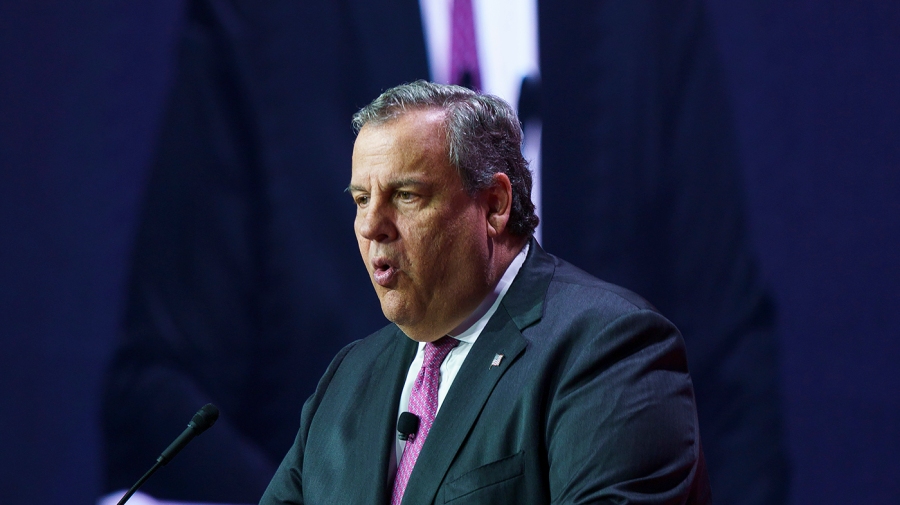World News
Christie knocks GOP rivals over ‘false choice’ on Ukraine on August 4, 2023 at 10:08 pm

Republican presidential candidate Chris Christie knocked his GOP rivals for presenting what he called a “false choice” over United States support in Ukraine.
During a trip to Ukraine, Christie called out former President Trump, Florida Gov. Ron DeSantis and entrepreneur Vivek Ramaswamy, who have all suggested that America scale back or cut off its aide to Kyiv to focus on domestic issues.
“We have people in the party like Trump and Ron DeSantis, Vivek, who are giving people a false choice, which is ‘Well, we can only do one thing; we can either improve things in the States or we can help Ukraine,” Christie said in an interview with The Washington Post.
“When you look at the amount of money we’ve sent to Ukraine as a percentage of the federal budget, anybody who can do the math knows that’s a ridiculous statement.”
Christie’s comments highlight the increasing divide among Republicans over the nation’s support for the war in Ukraine, both on the campaign trail and in Congress. Seventy Republicans voted in favor of an amendment last month that would have prohibited all future security assistance to Ukraine.
Christie, the former governor of New Jersey, made a surprise visit to Ukraine on Friday to meet with Ukrainian President Volodymyr Zelensky. The trip makes Christie the second GOP presidential candidate to travel to the embattled country after former Vice President Mike Pence visited in June.
“It was an honor to meet with President @ZelenskyyUa in Ukraine and see firsthand the heroism Ukrainians have displayed in their fight against Russia,” Christie said in a post on X, the platform formerly known as Twitter.
Christie also told The Washington Post he hoped Republican voters are thinking about which candidates can handle “the really complicated issues that the next next president will have to deal with….and who is going to be dealing with trying to keep themselves out of jail.”
Christie was referencing Trump and his ongoing series of legal battles, including his most recent indictment over his attempts to stay in power after losing the 2020 presidential election
Christie previously said he wants Ukraine to have “every weapon they need to be able to win,” in their fight against Russia. In an interview on NewsNation, Christie said he would increase U.S. commitment to Ukraine if he were to become the next president.
Trump, the frontrunner in the GOP race, has criticized the U.S.’ spending for Ukraine, arguing against the continued aid as Americans face financial challenges at home. Last week, the former president urged for a pause on all aid to Ukraine until federal agencies turn over “every scrap” of evidence connected to alleged “corrupt business dealings” from Biden and his son, Hunter Biden.
Florida Gov. Ron DeSantis (R) has shared similar sentiments, arguing there is not a “sufficient interest,” for the U.S. to “escalate” its involvement in the conflict. The White House hopeful walked back his controversial comments in March that characterized Russia’s war on Ukraine as a “territorial dispute.”
The U.S. has provided billions in support to Ukraine since its conflict with Russia began in February 2022.
A new poll from CNN found most Americans believe Congress should not authorize more funding for Ukraine. The poll found 55 percent of Americans said lawmakers should not authorize additional funding to support Ukraine, while 45 percent said they should.
The poll showed Republicans were more likely to oppose additional funding for Ukraine, with 71 percent saying Congress should not approve more funding, compared to 38 percent of Democrats and 55 percent of Independents.
Republican presidential candidate Chris Christie knocked his GOP rivals for presenting what he called a “false choice” over United States support in Ukraine. During a trip to Ukraine, Christie called out former President Trump, Florida Gov. Ron DeSantis and entrepreneur Vivek Ramaswamy, who have all suggested that America scale back or cut off its aide…
Politics
Netanyahu’s UN Speech Triggers Diplomatic Walkouts and Mass Protests

What Happened at the United Nations
On Friday, Israeli Prime Minister Benjamin Netanyahu addressed the United Nations General Assembly in New York City, defending Israel’s ongoing military operations in Gaza. As he spoke, more than 100 delegates from over 50 countries stood up and left the chamber—a rare and significant diplomatic walkout. Outside the UN, thousands of protesters gathered to voice opposition to Netanyahu’s policies and call for accountability, including some who labeled him a war criminal. The protest included activists from Palestinian and Jewish groups, along with international allies.

Why Did Delegates and Protesters Walk Out?
The walkouts and protests were a response to Israel’s continued offensive in Gaza, which has resulted in widespread destruction and a significant humanitarian crisis. Many countries and individuals have accused Israel of excessive use of force, and some international prosecutors have suggested Netanyahu should face investigation by the International Criminal Court for war crimes, including claims that starvation was used as a weapon against civilians. At the same time, a record number of nations—over 150—recently recognized the State of Palestine, leaving the United States as the only permanent UN Security Council member not to join them.
International Reaction and Significance
The diplomatic walkouts and street protests demonstrate increasing global concern over the situation in Gaza and growing support for Palestinian statehood. Several world leaders, including Colombia’s President Gustavo Petro, showed visible solidarity with protesters. Petro called for international intervention and, controversially, for US troops not to follow orders he viewed as supporting ongoing conflict. The US later revoked Petro’s visa over his role in the protests, which he argued was evidence of a declining respect for international law.

Why Is This News Important?
The Gaza conflict is one of the world’s most contentious and closely-watched issues. It has drawn strong feelings and differing opinions from governments, activists, and ordinary people worldwide. The United Nations, as an international organization focused on peace and human rights, is a key arena for these debates. The events surrounding Netanyahu’s speech show that many nations and voices are urging new action—from recognition of Palestinian rights to calls for sanctions against Israel—while discussion and disagreement over the best path forward continue.
This episode at the UN highlights how international diplomacy, public protests, and official policy are all intersecting in real time as the search for solutions to the Israeli-Palestinian conflict remains urgent and unresolved.
News
Is a Nuclear-Powered Alien Spacecraft Flying Toward Earth?

A mysterious interstellar object speeding through our solar system has reignited debates about extraterrestrial technology — and whether Earth might currently be under quiet observation.
The object, known as 3I/ATLAS, is only the third confirmed interstellar visitor ever detected. Unlike ordinary comets, however, this cosmic traveler has baffled astronomers with its unusual brightness, strange trajectory, and lack of a visible cometary tail. While most scientists cautiously describe it as a natural body, one leading astrophysicist believes something much stranger is at play.

Harvard Scientist’s Bold Claim
Professor Avi Loeb of Harvard University, head of the Galileo Project, has suggested that 3I/ATLAS may in fact be a nuclear-powered alien spacecraft designed to test how humanity would respond to an interstellar visitor. He argues that its flight path is improbably precise, bringing it close to Mars, Venus, and Earth — a pattern highly unlikely to occur by chance.
Loeb also points out that telescope images show a glow inconsistent with ordinary dust behavior. Instead of trailing behind like a comet, the halo-like light appears to extend in unusual ways, sparking debate about whether the object could be emitting energy of its own.
Headed Toward Earth’s Neighborhood
3I/ATLAS is expected to make its closest approach in late 2025, passing near Mars before swinging by the inner solar system. Although Earth itself will be on the opposite side of the Sun when it comes closest, the alignment will still enable space-based observatories to capture sharper data.

Loeb has called on NASA and other agencies to use spacecraft already stationed near Mars or Jupiter — including the Juno mission — to take high-resolution photographs. He believes such efforts could reveal whether the interstellar object is truly natural, or the first technological probe humanity has ever encountered.
Should We Be Worried?
While most astronomers argue caution before jumping to alien conclusions, Loeb insists that scientific openness is key. “If it’s just a comet, we learn something new,” he said. “But if it’s a spacecraft, it would be the most important discovery in human history.”
For now, 3I/ATLAS remains a mysterious speck on astronomers’ charts, drifting closer with each passing day. Whether it proves to be a frozen remnant of another star system or something far more advanced, the interstellar visitor has already succeeded in one mission: reminding us how vast and unpredictable the universe really is.
News
AI Automation Could Cause Up to 20% Unemployment—A Workforce on the Brink

Stark Warning from Anthropic CEO Highlights Rapid Job Displacement Risk
The looming threat of widespread unemployment due to AI automation has sparked intense debate among experts, business leaders, and policymakers. Dario Amodei, CEO of Anthropic—the company behind the influential AI language model Claude—issued a stark warning that has sent shockwaves through corporate America:

“Up to half of all entry-level white collar jobs could disappear within the next one to five years, potentially pushing unemployment rates as high as 20% during this period.”
This dramatic forecast paints a picture of a rapid and unsettling transformation in the workforce, driven by AI technologies that can perform complex cognitive tasks.
Balancing Predictions: Worst-Case Scenarios vs. Moderate Impact
However, this forecast represents one end of a spectrum of expert predictions. While Amodei’s warning highlights the worst-case scenario driven by the swift adoption of AI agents capable of coding, analyzing data, drafting legal documents, and managing workflows around the clock, other analyses suggest a more moderate impact. For example, Goldman Sachs estimates that AI could temporarily displace about 6-7% of U.S. jobs, with unemployment rising by approximately half a percentage point during the adjustment period. Their research anticipates a more gradual transition with a mixture of job disruption and creation.

The Unprecedented Speed and Scope of AI-Driven Job Disruption
The truth likely lies somewhere in between. AI is advancing at unprecedented speed, and the scope of jobs affected spans far beyond blue-collar roles to white-collar positions that required college degrees and years of training. Entry-level roles such as customer service representatives, data entry clerks, junior analysts, and administrative assistants face the greatest near-term risk. Mid-level roles in accounting, marketing, law, and engineering could soon follow, with companies already laying off workers citing AI-driven efficiencies.
Preparing for an AI-Transformed Workforce: Adaptation Is Essential
Ultimately, the AI-driven job transformation is no longer a distant prospect but unfolding now. Whether unemployment spikes to 20% or stabilizes at lower levels depends on many factors, including business adoption rates, government policies, and the ability of workers to reskill. What is certain is that the workforce of tomorrow will look very different from today—and the time to prepare is right now.

 Business3 weeks ago
Business3 weeks agoDisney Loses $3.87 Billion as Subscription Cancellations Surge After Kimmel Suspension

 Entertainment3 weeks ago
Entertainment3 weeks agoWhat the Deletion Frenzy Reveals in the David and Celeste Tragedy

 Entertainment4 weeks ago
Entertainment4 weeks agoABC Suspends ‘Jimmy Kimmel Live!’ Indefinitely After Kirk Remarks

 Entertainment3 weeks ago
Entertainment3 weeks agoExecutive Producer Debut: How Celia Carver Created Festival Hit ‘Afterparty’

 Film Industry4 weeks ago
Film Industry4 weeks agoCan Movie Theaters Steal the Show from Streaming?

 Health3 weeks ago
Health3 weeks agoRussia Claims 100% Success With New mRNA Cancer Vaccine

 News4 weeks ago
News4 weeks agoBody of Missing Teen Found in Tesla Linked to Musician D4vd

 Business4 weeks ago
Business4 weeks agoWhy Small Theaters Are Thriving While the Industry Struggles






























